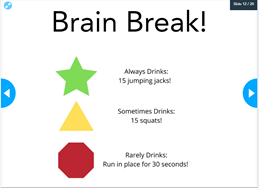UCCE Santa Barbara County educators partnered with P.E. teachers to boost enrolled classes by 53% during COVID-19 distance learning. About half of the students surveyed indicated intentions to drink more water and increase activity, contributing to improved youth health.
The Issue
The CalFresh Healthy Living, University of California Cooperative Extension (UCCE) program serving Santa Barbara County has partnered with elementary schools in the Santa Maria-Bonita School District (SMBSD) for several years to provide evidence-based curriculum and trainings in nutrition and physical activity. SMBSD serves over 16,900 students with 87.2% of the students qualifying for free or reduced-price school meals.[1] During the COVID-19 Pandemic, many families, especially those with young children, experienced an increase in food insecurity, making them more vulnerable to negative health outcomes.[2] Unfortunately, during the same time UCCE educators in Santa Barbara County experienced a decrease in K-6th grade classroom teachers being able to partner to provide nutrition and physical activity support, limiting access to important resources and information on diet and exercise habits that promote healthy living.[3-4]
How UC Delivers
Working closely with school partners, UCCE educators pivoted programming to meet the needs of school communities to promote health and increased the total number of enrolled classes by 53% compared to the start of the 2020-21 school year. 
The Impact
All three P.E Specialists expressed interest in continuing the partnership as extenders and felt the lessons were beneficial to their students. Two of the extenders reported the virtual UCCE lessons were easy to integrate into their class schedule and observed that students were actively engaged in the material and activities. Several additionalSMBSD P.E. Specialists expressed further interest in professional development around teaching nutrition curricula and have been provided access to a library of online resources and support from UCCE Educators.
Overall, this partnership resulted in reaching more than 1,000 students across two school sites with quality nutrition education using the Serving UpMyPlate and Up4It! curricula tailored to their grade level. As a result, 59% of 4th-6th grade youth surveyed (n=73) reported that when given a choice they will drink water and 45% reported that when given a choice they will try to engage in more physical activity.
According to the Physical Activity Guidelines for Americans (2018), regular moderate-to-vigorous physical activity reduces the risk of many chronic diseases among children and adults. These outcomes support UCANR's public value of promoting healthy people and communities.
“I have learned that in sports drinks, sodas, teas, and coffee that there is a lot of sugar and added sugar into the drinks. I have also learned that it is good to have some type of protein or dairy or anything that is on my plate when you eat.” – Rice Elementary Student (SMBSD)
References:
1. Ed-Data: Education Data Partnership, Santa Maria-Bonita School District; Accessed on 15 June 2021, http://www.ed-data.org/district/Santa-Barbara/Santa-Maria--Bonita
2. Wolfson JA, Leung CW. Food Insecurity and COVID-19: Disparities in Early Effects for US Adults. Nutrients. 2020; 12(6):1648. https://doi.org/10.3390/nu12061648
3. Pérez-Rodrigo, C., & Aranceta, J. (2001). School-based nutrition education: Lessons learned and new perspectives. Public Health Nutrition, 4(1a), 131-139. doi:10.1079/PHN2000108
4. Rivera, R. L., Maulding, M. K., & Eicher-Miller, H. A. Effect of Supplemental Nutrition Assistance Program–Education (SNAP-Ed) on food security and dietary outcomes, Nutrition Reviews, Volume 77, Issue 12, December 2019, Pages 903–921, https://doi.org/10.1093/nutrit/nuz013
